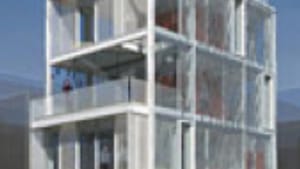Stay in the Loop
BSR publishes on a weekly schedule, with an email newsletter every Wednesday and Thursday morning. There’s no paywall, and subscribing is always free.
Pre-fab housing:
Confessions of a convert
Pre-fab dwellings at MOMA in New York

Thanks to MOMA’s exhibition on “Home Delivery: Fabricating the Modern Dwelling,” I’ve done a complete U-turn on the subject of prefab housing.
Where I grew up, factory-made homes meant trailer trash or cookie-cutter suburban sprawl. Now I see an amazing yellow-bodied, pink-legged “Zip Up Enclosure” (by architects Richard and Su Rogers)— and I start imagining how I can make it a country retreat.
Regrettably, the Rogers prefab hasn’t yet but built: It’s actually a proposal feature in the New York Museum of Modern Art’s historical survey on the sixth floor. Outdoors on an empty lot next door, you can see and explore five real-life factory-made homes, all constructed in a matter of days, just for “Home Delivery.” Each of these dwellings is a different kind of wonder, and all feature truly innovative, state-of-the-art technology.
Most notable is the “Cellophane House” designed by Philadelphia’s own KieranTimberlake Associates. Visually, this handsome four-story modernist structure belongs very much in the tradition of Phillip Johnson’s “Glass House”; yet “Cellophane House” is technologically more sophisticated, and economically it’s much, much more feasible for middle-income Americans. Unlike Johnson’s ‘Glass House,” “Cellophane House” can be built site-specific, and it’s designed to meet individual need through what the architects call “mass customization.” (For more information, visit www.momahomedelivery.org.)
For me, it was worth a day trip to New York just to see this amazing house and to participate in a genuine “urban happening.” The crowd all around me was intensely engaged in the show: praising and damning, imagining sleeping or eating in the strange little rooms, wondering if they had the “discipline” to live in such challenging new environments.
Some found these houses utterly impractical; others pronounced them a good alternative to crowded-over living. Almost everyone I heard criticized the kitchens and bathrooms as inadequate, except in the “Cellophane House,” which is certainly the biggest and most livable of the five structures exhibited.
In terms of its interior design, the KieranTimberlake house poses a number of challenges, which were not addressed in the empty model. Of course I couldn’t resist decorating all the rooms in my mind. Here’s what I’d do:
Integration of the exterior and interior environments: Since “Cellophane House” is basically transparent and much balconied, in an ideal world I’d begin by landscaping the immediate grounds. A “landscaped” garden modeled after Frank Lloyd Wright’s Taliesin West would suit “Cellophane House” very well (as portrayed in Met Home’s October 2006 issue). The Granite structures and gravel paths are interspersed with Japanese red maple and blue green conifers to great effect.
Color scheme: Instead of conforming with the usual black/white or beige/gray schemes found in most modernist interiors, I would introduce more comforting colors drawn from the immediate exterior: nature’s soft reds, terracottas and golden yellows. “Cellophane House” is intrinsically cold: hence I would concentrate on warm, friendly hues.
Functional arrangement: Given the modest size of the rooms and the strong rectilinearity of the interiors, I would choose medium- and small-scaled upholstered furnishings with similar shapes. And since storage is a huge problem, I’d introduce a number of multipurpose pieces.
For example, I’d choose a bed with drawers underneath and float it in the middle of the bedroom, using an armoire’s back as its headboard. In the living room, I’d choose a coffee table that could do double duty as a dining table, and end tables with storage components.
Artworks, books and accessories: For those of us with extensive collections, living in a factory-built house would be a genuine challenge. I myself would oust the cars from the first-floor garage and turn it into a library/office with extensive bookshelves on actual walls. In the living room and bedrooms, artworks could be hung from aluminum ceiling supports and could literally float around the outskirts of these rooms. I would keep accessories to a minimum but include useful pieces that look like freestanding sculpture, such as “Blow Up Umbrella Stand” by Fratelli Campana for Alessi, or “Opus Shelving” from Design Within Reach.
These are just a few thoughts about how to personalize a factory-built space. That extra effort is definitely worthwhile, since these homes provide us with intelligent solutions to many pressing environmental issues; population growth, sustainability and escalating cost factors in the building industry. â—†
Fourth in a series of articles on home design.
To read the first article in the series, click here.
To read the next article, click here.
Where I grew up, factory-made homes meant trailer trash or cookie-cutter suburban sprawl. Now I see an amazing yellow-bodied, pink-legged “Zip Up Enclosure” (by architects Richard and Su Rogers)— and I start imagining how I can make it a country retreat.
Regrettably, the Rogers prefab hasn’t yet but built: It’s actually a proposal feature in the New York Museum of Modern Art’s historical survey on the sixth floor. Outdoors on an empty lot next door, you can see and explore five real-life factory-made homes, all constructed in a matter of days, just for “Home Delivery.” Each of these dwellings is a different kind of wonder, and all feature truly innovative, state-of-the-art technology.
Most notable is the “Cellophane House” designed by Philadelphia’s own KieranTimberlake Associates. Visually, this handsome four-story modernist structure belongs very much in the tradition of Phillip Johnson’s “Glass House”; yet “Cellophane House” is technologically more sophisticated, and economically it’s much, much more feasible for middle-income Americans. Unlike Johnson’s ‘Glass House,” “Cellophane House” can be built site-specific, and it’s designed to meet individual need through what the architects call “mass customization.” (For more information, visit www.momahomedelivery.org.)
For me, it was worth a day trip to New York just to see this amazing house and to participate in a genuine “urban happening.” The crowd all around me was intensely engaged in the show: praising and damning, imagining sleeping or eating in the strange little rooms, wondering if they had the “discipline” to live in such challenging new environments.
Some found these houses utterly impractical; others pronounced them a good alternative to crowded-over living. Almost everyone I heard criticized the kitchens and bathrooms as inadequate, except in the “Cellophane House,” which is certainly the biggest and most livable of the five structures exhibited.
In terms of its interior design, the KieranTimberlake house poses a number of challenges, which were not addressed in the empty model. Of course I couldn’t resist decorating all the rooms in my mind. Here’s what I’d do:
Integration of the exterior and interior environments: Since “Cellophane House” is basically transparent and much balconied, in an ideal world I’d begin by landscaping the immediate grounds. A “landscaped” garden modeled after Frank Lloyd Wright’s Taliesin West would suit “Cellophane House” very well (as portrayed in Met Home’s October 2006 issue). The Granite structures and gravel paths are interspersed with Japanese red maple and blue green conifers to great effect.
Color scheme: Instead of conforming with the usual black/white or beige/gray schemes found in most modernist interiors, I would introduce more comforting colors drawn from the immediate exterior: nature’s soft reds, terracottas and golden yellows. “Cellophane House” is intrinsically cold: hence I would concentrate on warm, friendly hues.
Functional arrangement: Given the modest size of the rooms and the strong rectilinearity of the interiors, I would choose medium- and small-scaled upholstered furnishings with similar shapes. And since storage is a huge problem, I’d introduce a number of multipurpose pieces.
For example, I’d choose a bed with drawers underneath and float it in the middle of the bedroom, using an armoire’s back as its headboard. In the living room, I’d choose a coffee table that could do double duty as a dining table, and end tables with storage components.
Artworks, books and accessories: For those of us with extensive collections, living in a factory-built house would be a genuine challenge. I myself would oust the cars from the first-floor garage and turn it into a library/office with extensive bookshelves on actual walls. In the living room and bedrooms, artworks could be hung from aluminum ceiling supports and could literally float around the outskirts of these rooms. I would keep accessories to a minimum but include useful pieces that look like freestanding sculpture, such as “Blow Up Umbrella Stand” by Fratelli Campana for Alessi, or “Opus Shelving” from Design Within Reach.
These are just a few thoughts about how to personalize a factory-built space. That extra effort is definitely worthwhile, since these homes provide us with intelligent solutions to many pressing environmental issues; population growth, sustainability and escalating cost factors in the building industry. â—†
Fourth in a series of articles on home design.
To read the first article in the series, click here.
To read the next article, click here.
Sign up for our newsletter
All of the week's new articles, all in one place. Sign up for the free weekly BSR newsletters, and don't miss a conversation.

 Caroline Dunlop Millett
Caroline Dunlop Millett